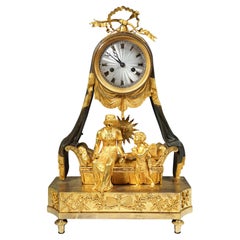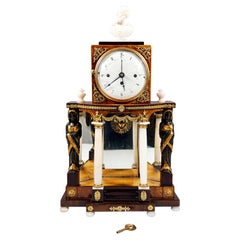Want more images or videos?
Request additional images or videos from the seller
1 of 8
French Ormolu Table Clock, Bacchante Dancing With Tambourine, Paris, Around 1810
Price:$2,787.48
$3,432.10List Price
About the Item
- Dimensions:Height: 9.45 in (24 cm)Width: 5.91 in (15 cm)Depth: 3.15 in (8 cm)
- Style:Empire (Of the Period)
- Materials and Techniques:
- Place of Origin:
- Period:
- Date of Manufacture:circa 1810
- Condition:Wear consistent with age and use. Very well maintained overall condition, movement checked by master clockmaker, completely cleaned and fully functional, key present.
- Seller Location:Vienna, AT
- Reference Number:1stDibs: LU1014442097502
About the Seller
5.0
Platinum Seller
Premium sellers with a 4.7+ rating and 24-hour response times
Established in 1988
1stDibs seller since 2013
312 sales on 1stDibs
Typical response time: 3 hours
Authenticity Guarantee
In the unlikely event there’s an issue with an item’s authenticity, contact us within 1 year for a full refund. DetailsMoney-Back Guarantee
If your item is not as described, is damaged in transit, or does not arrive, contact us within 7 days for a full refund. Details24-Hour Cancellation
You have a 24-hour grace period in which to reconsider your purchase, with no questions asked.Vetted Professional Sellers
Our world-class sellers must adhere to strict standards for service and quality, maintaining the integrity of our listings.Price-Match Guarantee
If you find that a seller listed the same item for a lower price elsewhere, we’ll match it.Trusted Global Delivery
Our best-in-class carrier network provides specialized shipping options worldwide, including custom delivery.You May Also Like
Louis-Philippe Ormolu Clock, Esmeralda or Dancer with a Tambourine
Located in Paris, FR
Early 19th century Louis-Philippe figural Ormolu clock featuring an oriental woman playing tambourine. She wears a crown of flowers and a rich pearl jewelry displays. The dancer is Esmeralda, a 16 years old Gypsie girl in Victor Hugo's 1831 novel The Hunchback of Notre-Dame (Notre-Dame de Paris). The patinated bronze dial is composed of twelve, white enamel cartridges that mark the hours with Roman numerals. This antique desk clock...
Category
Antique 19th Century French Louis Philippe Mantel Clocks
Materials
Bronze
$4,970
H 21.26 in W 13.39 in D 5.91 in
Ormolu Mantel Clock, Belgium, circa 1810-1820
Located in Belmont, MA
Empire ormolu mantel clock, Belgium, circa 1810, Signed "J.B. Romaet a Gand". Decorated with a shepherd scene. Strikes the hour and half hour on a bell. With enamel clock face and si...
Category
Antique 1810s Belgian Empire Mantel Clocks
Materials
Ormolu
Early 19th Century Ormolu Mantel Clock, Atala freeing Chactas, Paris, circa 1810
Located in Greven, DE
Mantel Clock "Atala and Chactas"
Paris
Bronze (fire-gilt and patinated), enamel
Empire around 1810
Dimensions: H x W x D: 40 x 32 x 11 cm
Description:
Very rare and extremely high quality French mantel clock, so-called Pendule Au Bon Sauvage.
Depicted are scenes from the love story "Atala or the love of two savages in the desert" written by Francois René Vicomte de Chateaubriand in 1801. At the beginning of the 19th century, this was probably the most famous love story in Europe, but today it has been forgotten.
The story, set in present-day Louisiana (USA), is roughly rewritten about the forbidden love between Chactas, a young Indian, and Atala, the beautiful daughter of a Spaniard.
Chactas is captured in a battle between two Indian tribes, chained to a palm tree and is to be sacrificed. Atala wants to save his life and convert him to Christianity. She unties him from the palm tree at night and they flee together into the wilderness of North America. Their love for each other grows stronger and stronger and they have prospects for a future together.
The story takes a tragic turn when Atala, who must remain a virgin due to a vow made by her mother, can no longer withstand the conflict of her feelings and commits suicide.
The main group of characters thus shows Chacta's liberation through Atala. Atala is leaning against a pile of logs. The animal fur thrown over the logs and the weapons leaning against the stack on the right give the impression of a night camp.
The bronze is of rarely beautiful quality, finely chiselled and makes the scene appear very lively. The contrast of fire-gilded and patinated bronze adds tension to the composition.
In the base we see the Entombment as the end of the tragic love story. This bronze work is also very detailed, the interplay of bright and matt gilding makes the flat relief appear much deeper than it is.
The depiction of the mantel clock presented here shows that the exotic was only known from stories and that the bronzier had his own ideas about the appearance of this distant world. The Indian, for example, has very European facial features and his skin was not black in reality, of course. The palm tree was also certainly not found in the North American wilderness.
The heart of the clock is a French pendulum movement, integrated into the wooden pile, with an eight-day power reserve and a lock plate striking a bell on the half and full hour. The pendulum is suspended on a thread, typical of the period. The classically shaped hands, so-called Breguet hands, are also typical of the time.
The enamelled dial has black Roman hour numerals, Arabic quarter hours and bears the signature: Le Roy hr. de Madame A PARIS.
Interesting facts:
The period from 1795 to about 1815 saw the creation of probably the most spectacular group of bronzes: The "Au bon Sauvage" pendulums - depictions of the "Noble Savage".
Today's viewers react to these objects with both fascination and irritation. Enthusiastic on the one hand about the obvious quality of the detailed bronzes and the allure of the exotic, on the other hand distanced and cautious because of the possible discrimination that is suspected behind them. The ambivalence of this feeling motivates the search for the conditions of origin of these pendulums.
Europeans found their new ideal of the natural man primarily in fictional and realistic travelogues about the Indians of North America...
Category
Antique Early 19th Century French Empire Mantel Clocks
Materials
Ormolu
$25,444
H 15.75 in W 12.6 in D 4.34 in
French Empire Ormolu Mantel Clock by Deverberie a Paris, Fire-Gilded
Located in Berlin, DE
French Empire mantel clock from DeVerberie a Paris.
Fire-gilded.
Age-related condition.
Category
Antique 19th Century Empire Mantel Clocks
Materials
Bronze
$6,154 Sale Price
20% Off
Free Shipping
H 20.67 in W 14.18 in D 4.73 in
Empire Mantel Clock - La Bibliotheque, Ormolu, France, Paris, circa 1820
By Le Roi
Located in Greven, DE
Mantel Clock - La Bibliotheque - In the study room
Paris
fire-gilt bronze, enamel
Empire around 1820
Dimensions: H x W x D: 38 x 28 x 19 cm
Description:
Scenery mounted on an oval...
Category
Antique Early 19th Century French Empire Mantel Clocks
Materials
Bronze
$8,876
H 14.97 in W 11.03 in D 7.49 in
Antique French Gilt Bronze Empire Neoclassical Statue Clock by Rabiat Paris 1810
Located in Portland, OR
Incredible investment quality antique French gilded bronze Empire eight day clock, "Allegory of Poetry" Claude François Rabiat circa 1810, in excellent condition.
The clock depicts ...
Category
Antique 1810s French Empire Mantel Clocks
Materials
Marble, Bronze, Enamel
$11,000
H 20 in W 13 in D 8 in
French Empire Ormolu and Patinated Bronze Mantel Clock Signed Vaillaint a Paris
Located in London, GB
Superb quality French Empire ormolu and patinated bronze mantel clock in a beautifully restrained case. The casting and gilding of the finest quality. A classically dressed maiden st...
Category
Antique Early 1800s French Empire Mantel Clocks
Materials
Ormolu, Bronze
$8,383
H 19.3 in W 11.82 in D 5.91 in
French Empire Gilt Bronze Mantle Clock , France 1810
Located in New York, NY
Resting on four very elegant feet the clock features a rectangular base decorated on three sides with classical motifs. The face features a pair of Sphinx flanking a wreath with lau...
Category
Antique 1810s French Empire Mantel Clocks
Materials
Bronze
Royal Empire Mantel Clock / Pendulum Clock, Fire-Gilt, Around 1805-1815, Paris
Located in Berlin, DE
Royal Empire mantel clock / pendulum clock, fire-gilt, around 1805-1815, Paris
Solid bronze, fire-gilded, Paris around 1805-1815, original French Empire from the first period.
...
Category
Antique Early 1800s French Empire Mantel Clocks
Materials
Bronze
$7,680
H 19.69 in W 15.75 in D 5.91 in
French Empire Ormolu Mantel Clock
Located in Norwich, GB
French Empire Ormolu mantel clock resting on four turned feet supporting an oval base with raised garland and zig-zag rope decoration...
Category
Antique Early 1800s French Empire Mantel Clocks
Materials
Ormolu
More From This Seller
View AllFrench Ormolu Table Clock, Bacchant Sitting On Wine Barrel, Paris, Around 1840
Located in Vienna, AT
Fire-gilded bronze table clock: a childlike bacchanal seated on a wine barrel under an arched vine arbour, holding grapes and a wine glass in his hands, on an oval base with an appli...
Category
Antique 1840s French Empire Table Clocks and Desk Clocks
Materials
Bronze
French Ormolu Mantle Clock, Pendule 'Lit à Baldaquin', Paris, Around 1790
Located in Vienna, AT
Excellent fire-gilded Empire bronze mantel clock: structure in the form of a rectangular, stepped pedestal that tapers at the front corners, on four spindle feet, with relief ornamen...
Category
Antique 1790s French Louis XVI Table Clocks and Desk Clocks
Materials
Bronze
Viennese Empire Portal Clock With Caryatids And Gilded Fittings, Around 1810
By Viennese Manufactory
Located in Vienna, AT
Complete Vienna clock on six stocky ball feet made of alabaster, architecturally structured wooden case with fruitwood veneers in the shape of a portal, steps in front flanked by two...
Category
Antique 1810s Austrian Empire Sterling Silver
Materials
Alabaster, Brass
French Ormolu Mantle Clock, Pendule 'L'Angelot Endormi', Reiche, Paris, Ca 1820
Located in Vienna, AT
Excellent mantel clock made of fire-gilded and patinated bronze from the early 19th century:
Structure in the form of a tall oval, smooth, fluted stepped gilded base, recessed body m...
Category
Antique 1820s French Empire Table Clocks and Desk Clocks
Materials
Bronze
French Museum Ormolu Mantle Clock, Pendule 'Au Char', Thomire, Paris, Ca 1820
By Pierre-Philippe Thomire
Located in Vienna, AT
Exquisite mantel clock made of fire-gilded and patinated bronze from the early 19th century:
Structure in the form of a rectangular gilded base on four conical feet with chiselling, ...
Category
Antique 1820s French Empire Table Clocks and Desk Clocks
Materials
Bronze
Viennese Silver Historicism Splendour Clock With Musical Movement, Around 1880
By Viennese Manufactory
Located in Vienna, AT
Artfully decorated silver gilded table clock by a Viennese master:
Flat, rectangular corpus containing the musical mechanism, standing on four elaborately decorated volute feet attac...
Category
Antique 1880s Austrian Other Sterling Silver
Materials
Amethyst, Malachite, Gold Plate, Silver, Enamel



